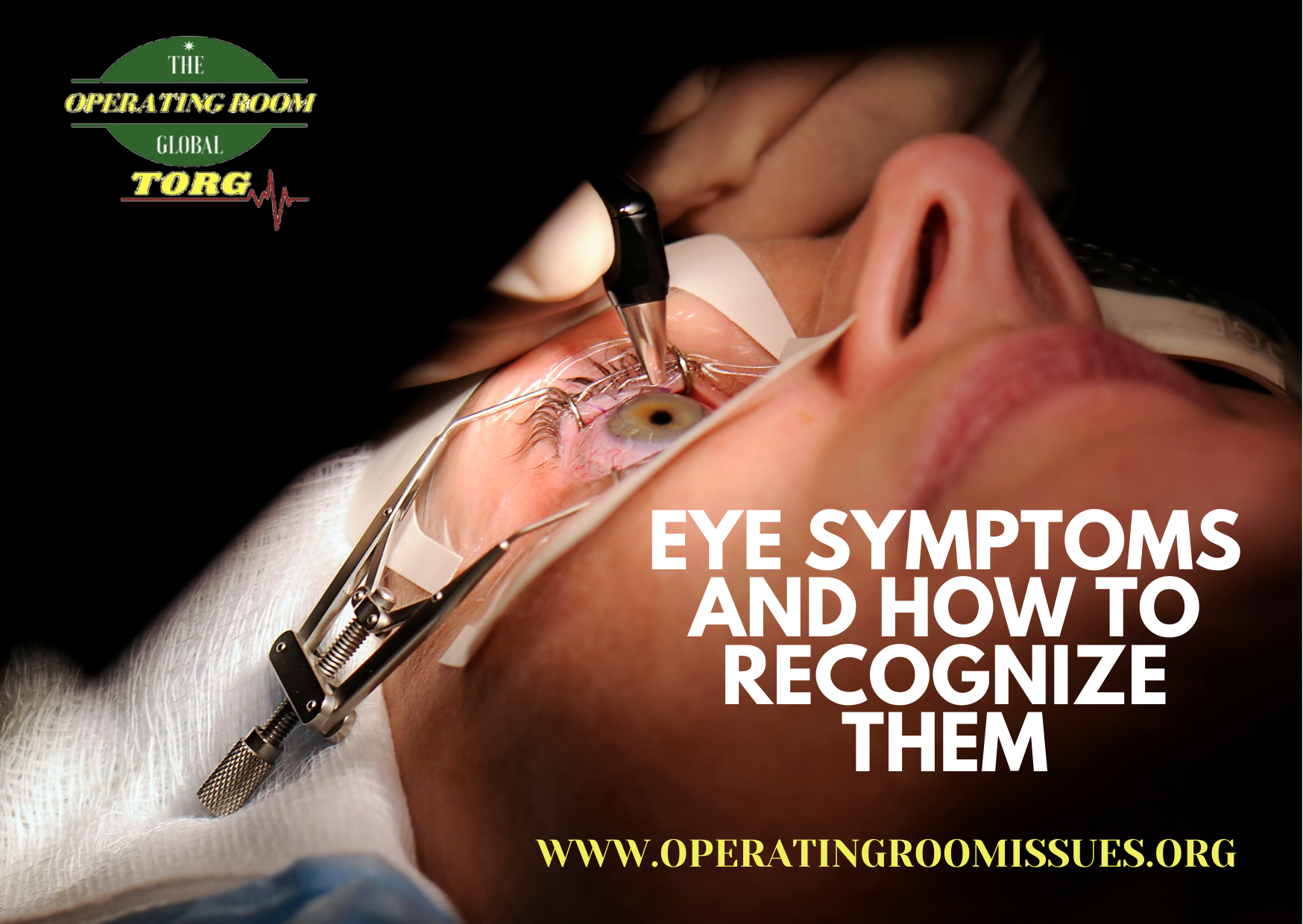| Blurred Vision | Eye Redness |
| Burning Sensation in Eye | Flaky Eyelid |
| Central Vision Loss | Floaters |
| Cloudy Vision | Foreign Body in the Eye |
| Colour Blindness | Glare |
| Distorted Vision | Halos Around Lights |
| Double Vision | Itchy Watery Eye |
| Eye Discharge | Swollen Eyes |
| Eye Flashes | Tired Eyes |
| Eye Pain | Tunnel Vision |
Blurred Vision
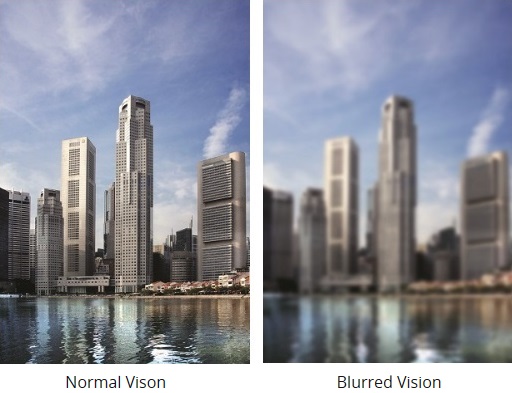
Blurred vision is the inability to clearly see objects that are either far away or up close. It is commonly a sign of a refractive error like short-sightedness (myopia), long-sightedness (hyperopia), astigmatism or presbyopia (“Lao Hua”). These refractive errors can be corrected with vision correction aids such as spectacles, contact lenses, or with the help of laser refractive eye surgery.
Blurred vision can also be caused by dry eyes and cataract as well as more serious eye conditions such as glaucoma and age-related macular degeneration (AMD).
Burning Sensation in the Eye
Burning sensation in the eye can be caused by allergy, dryness, tiredness, vision stress (like computer work) or a combination of the aforementioned factors.
The possible causes for burning sensation in the eye include:
- Allergies
- Wearing your contact lenses for prolonged periods
- Exposure to environmental pollutants such as tobacco smoke, or dust
- Extremes of cold or hot dry air
- Chemicals found in household cleaning solvents such as bleach, soap and shampoo
- Chlorine in swimming pools
The treatment for burning eyes varies depending on the cause. In many cases, the burning sensation goes away by itself when you get away from the irritating factor, such as smoke. In other cases, use of over-the-counter artificial tears or antihistamines can relieve burning eyes. If you have conjunctivitis caused by bacteria, your eye doctor may prescribe antibiotic eye drops or ointment.
Eye Redness
Eye redness may be due to swollen or dilated blood vessels, which cause the surface of the eye to look red. This happens when the vessels in the surface of the white portion of the eye (sclera) become enlarged and irritated. This may result from extremely dry air, sun exposure, dust, foreign body, an allergic reaction, infection, trauma, or other conditions.
Eye infections are conditions caused by microbiological agents such as viruses and bacteria that may cause your eyes to become red and swollen. Conjunctivitis (pink eye) is the most common eye infection. It is an inflammation of the conjunctiva and the inner surface of the eyelids, usually due to a viral or bacterial infection. Sometimes, it can also be due to underlying allergic condition.
The other common kind of redness may be due to subconjunctival haemorrhage, or ‘bloodshot eyes’. This is due to a broken vessel in the eye, which appears very red over the underlying white portion of the eye (sclera). Bloodshot eyes may be accompanied by discomfort or tearing but is usually painless. It may be due to trauma or can occur spontaneously when the fine capillaries of the eye burst from sneezing, straining, vomiting or heavy lifting.
They usually will heal without treatment after a few days to one week. You should consult a doctor should your red eye be associated with pain, blurring of vision, persistent un-resolving red eye or trauma.
Flaky Eyelid
If you have flaky, peeling skin on your eyelids, it is likely caused by a skin condition known as blepharitis. The skin on your eyelids may be itchy, appear swollen, red, flaky and crusty and you may feel like you are having foreign debris in your eyes.
Itchy or flaky lids are irritating, but rarely serious. It is possible to reduce this irritation by keeping your eyelid clean and using artificial tears. If you have blepharitis that does not respond to regular cleaning, you may need to see an eye doctor for further course of treatment, as these may be symptoms of other underlying skin conditions such as rosacea, or Dermodex (eyelash mite) infestation.
Central Vision Loss
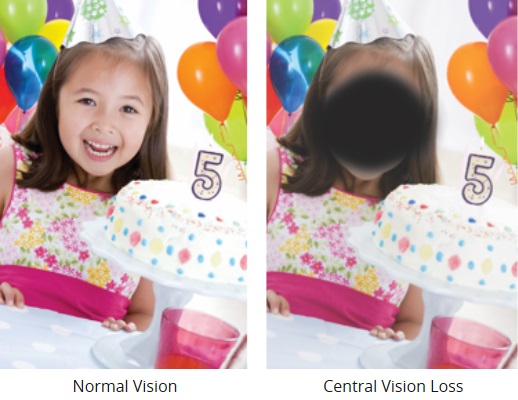
Central vision loss can occur when a person suffers from age-related macular degeneration and/or diabetic retinopathy. It starts with a small dark spot in the centre of the vision that gets larger over time. Central vision loss can progress very quickly. If this happens, you should consult an eye doctor for an evaluation immediately.
Other causes of central vision loss include cataracts, macular degeneration and holes as well as complications from conditions such as multiple sclerosis. In some cases, central vision loss can be the result of brain tumours or aneurysm. This type of vision loss involves loss of sight in the central area of the visual field and may affect one or both eyes depending on the contributing cause. Treatment depends on the causative condition.
Floaters
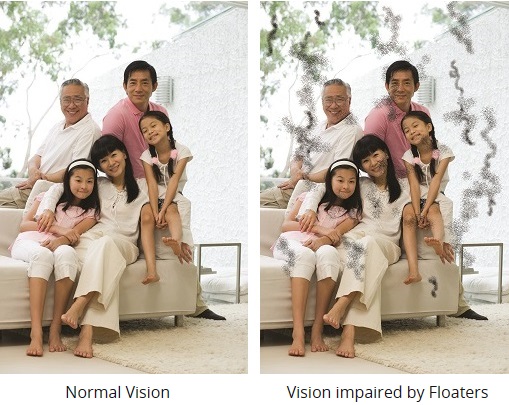
The dark, distinct spots you sometimes see in your field of vision are called floaters. Floaters occur when small clumps of the vitreous (a jelly-like fluid) inside the eye detach from the inner wall of the eye as we age, otherwise known as posterior vitreous detachment. This is a common benign degeneration that occurs when our vitreous jelly starts to dissolve and liquefy with age, resulting in a watery centre and clumps of undissolved gel floating in the centre of the eye, hence we see a clump of ‘floater’ in the vision. Seeing floaters are common and mostly benign, but it can be an indication of a more serious problem like diabetic retinopathy which causes blood vessels in the retina to weaken and burst. Floaters can also be caused by retina tear and retinal detachment, a serious condition when the retina of the eye breaks and detaches from the rest of the layers of the eye. If you see a sudden onset of floaters, especially accompanied with flashing lights or blurring of vision, please consult your eye doctor for early diagnosis and treatment.
Foreign Body in the Eye
Any material such as dust, sand or paint that gets into the eye is called a foreign body. Foreign bodies fall into two categories:
- Superficial foreign bodies: these stick to the front of the eye or get trapped under one of the eyelids, but do not enter the eye.
- Penetrating foreign bodies: these penetrate the outer layer of the eye (cornea or sclera) and enter the eye. These objects are usually travelling at high speed and are commonly made of metal.
Superficial foreign bodies are not usually serious, but may cause discomfort, red eyes and gritty sensation. If the superficial foreign body is stuck underneath the eyelid there may be pain with each blink.
A penetrating eye injury can be extremely serious as it may lead to blindness if not detected and treated promptly. Please seek consult with an eye doctor immediately should you have a foreign body enter your eye while perform high velocity activities such as grinding or hammering metal, especially when associate with pain or blurring of vision.
If you get a superficial foreign body in your eye, first-aid treatment such as gentle rinsing with warm water is appropriate. An ‘eye bath’ can make this easier to do on your own, or you can get someone to help rinse the eye from the side, with you lying down.
Do not try to remove a foreign body with cotton buds or any other type of solid object. It is advisable to consult a doctor if you think you have a foreign body in your eye and it continues to cause irritation.
Cloudy Vision

Having cloudy vision or having your vision obscured, as if you are seeing objects through a mist, can be a sign of cataracts. This condition, which is usually age-related, is progressive and can lead to blindness if left untreated. Nowadays, cataracts can be quite easily managed, so it is important to diagnose the disease as early as possible.
Cloudy vision can also be caused by other rarer medical conditions such as Vitamin A deficiency, sexually transmitted disease and eye tumours. If you are suffering from cloudy vision, do see your eye doctor for early diagnosis and treatment.
Halos Around Lights

Seeing haloes around lights is a symptom where coloured or luminous rings are seen around lights such as street lights or other light sources.
Haloes around bright lights tend to be especially worse when driving at night and can interfere with vision and are hence, potentially dangerous. They are commonly associated with glare, a symptom characterised by difficulty looking at bright light as it hurts the eyes, resulting in blurring of vision and tearing.
These symptoms are more common in older people, and in those who have had certain types of refractive surgery or who have certain types of cataracts. Haloes can also occur in people with dry eyes or people whose pupils are widely dilated (for example, those who have been given eye drops for an eye examination).
Distorted Vision

Distortion of vision is an inability to see clearly and correctly. Straight lines may appear bent, crooked, or wavy.
Usually this is caused by distortion of the retina, specifically in the macula area. This distortion can herald macular degeneration. If you have distorted vision, you should seek medical attention by an eye doctor promptly. Other conditions leading to swelling of the retina can cause this distortion, such as macular edema and central serous chorioretinopathy.
Glare

Vision impaired by Glare
Glare is a visual impairment that occurs when the amount of stray light entering the eye getting scattered. It reduces visual contrast, resulting in symptoms of poor vision and discomfort, especially difficulty looking at bright lights (such as seeing on-coming car headlights).
While almost everyone experiences glare at some point, factors such as age, eye colour, pupil size, uncorrected refractive error and eye conditions such as dry eyes, cataracts and just having had any eye surgery done are the most common contributors.
A trial of eyedrops for dry eyes, wearing sunglasses or prescription glasses if there’s any refractive error if one experiences glare, but you should seek an eye doctor’s consult if there is persistent glare or visual impairment.
Colour Blindness

You could be suffering from colour blindness if you are unable to distinguish red, green or blue colours.
The most common form of colour blindness is known as red/green colour blindness. For the vast majority of people with deficient colour vision, the condition is genetic and inherited from their mother, although some people become colour blind as a result of diseases such as certain inherited retinal diseases, diabetes and multiple sclerosis or they acquire the condition over time due to the ageing process (age-related macular degeneration) or consumption of certain medication.
Double Vision
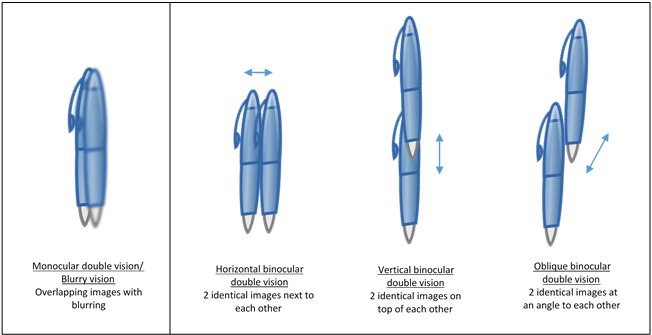
Double vision, also called diplopia, is a symptom whereby a patient sees two images of a single object. It can be either monocular diplopia where the problem affects one eye only, or binocular diplopia where the problem comes from misalignment of both eyes.
In monocular diplopia, the double vision affects one eye and is present even when the other unaffected eye is covered. Monocular diplopia can be caused by uncorrected refractive errors, corneal disorders, cataracts and retinal disorders.
Binocular diplopia arises as a result of misalignment of the two eyes. The double image is only present when both eyes are open and disappears when either eye is covered. Based on the kind of misalignment the double vision can be horizontal, vertical or oblique. Binocular double vision can be caused by disorders affecting the nerves, eye muscles, nerve-muscle junction or socket bones of the eye.
If experiencing double vision, it is important to check if the double vision is monocular or binocular by covering each eye in turn. This will help your doctor distinguish the likely cause of the double vision.
Itchy Watery Eye
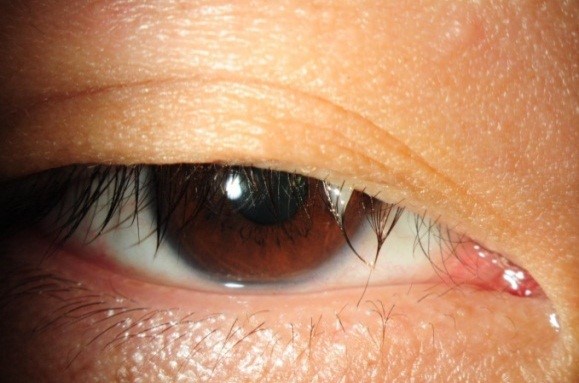
If you are suffering from prolonged itchiness and excessive watering of the eyes, you may have allergies caused by pollen, pet hair, dust, perfume or other substances in your environment. The condition can be uncomfortable, but does not usually result in significant vision loss. Your eye doctor can determine the cause of your eye discomfort and advise treatment.
Eye Discharge
Eye discharge refers to the sticky, yellowish and crusty substance that can sometimes make your eyes feel glued shut. It can be temporary such as when you wake up in the morning, or persistent in which case medical attention should be considered.
There are many causes of eye discharge, ranging from infections to allergic reactions. Most causes of eye discharge are not serious and can be easily treated.
People who are unwell (with cold or flu) may also have more eye discharge. Pollen, gusty winds, dry eyes or an eyelash can cause an irritation which may also lead to the discharge.
More serious causes of eye discharge may be infectious conjunctivitis and corneal ulcers. Both of these conditions can lead to further complications, so if you are experiencing pain, eye swelling or visual changes in addition to eye discharge, you should consult your eye doctor immediately.
Swollen Eye
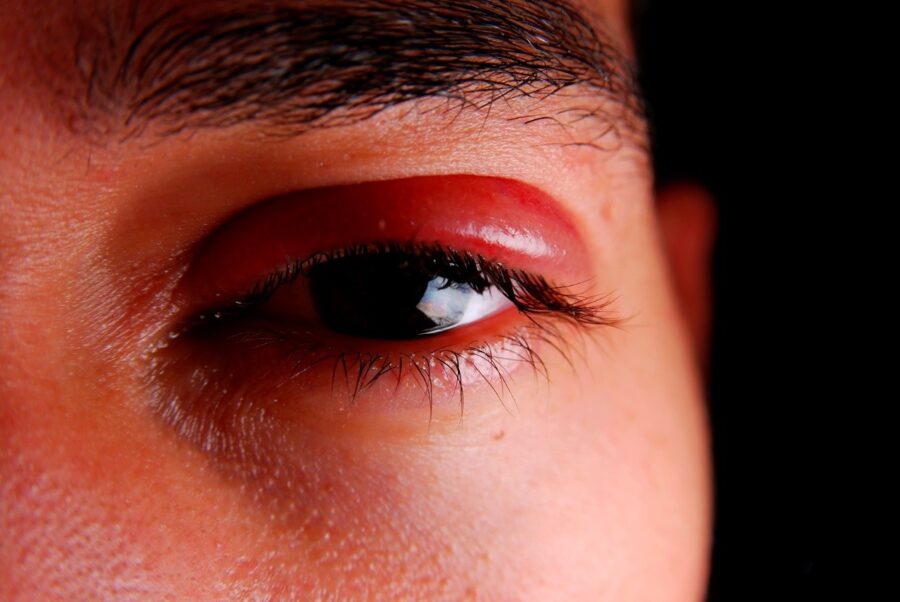
Swelling of the eyes refers to the presence of excess fluid (oedema) in the connective tissues around the eye along the eyelids.
Various causes of a swollen eye include conjunctivitis; blepharitis; infections; insect bites; and allergies to new drugs or cosmetics. More serious, potentially sight-threatening causes of eyelid swelling include orbital cellulitis, thyroid eye disease and trauma or injury to the eye area.
Since the causes are wide-ranging, you should make an appointment to discuss your symptoms with an eye doctor and undergo an eye examination. Your condition can thus be treated appropriately and effectively.
Tunnel Vision
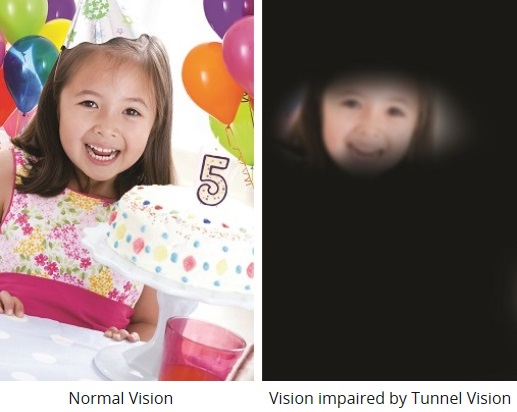
If your central vision is fine, but the areas outside your central field of vision start to lose clarity or detail, you may be losing your peripheral vision.
Peripheral vision allows you to see objects all around you without turning your head, and is responsible for detecting motion at the edges of our field of view to sense incoming danger. The remaining central field of vision makes it seem as though you are looking through a tunnel, hence the term “tunnel vision”. The loss of peripheral vision is not only debilitating – it also poses a major safety hazard.
One key cause of loss of peripheral vision is glaucoma, where the build-up of fluid and pressure within your eye damages the delicate fibres of the optic nerve. These delicate nerve fibres are responsible for carrying visual impulses from your eye to the brain. The damage is irreversible and can lead to blindness in advanced cases. However, early diagnosis and treatment can prevent vision loss from glaucoma.
Eye Pain

Pain in the eye may be described as a burning, throbbing, aching, or stabbing sensation in or around the eye. It may also feel as if there is a foreign body in the eye.
A wide variety of disorders can cause pain in or around the eye. If the pain is persistent, severe, or associated with decreased vision, seek medical attention immediately. Some of the problems that can cause eye pain are:
- Stye (hordeolum) / inflammation of the upper and lower lids
- Conjunctivitis (pink eye)
- Contact lens complications
- Corneal problems (infection or injury such as a corneal abrasion)
- Sudden glaucoma
- Uveitis (inflammation inside the eye)
- Migraine headaches
- Sinus problems
- Viral infections such as the flu
Tired Eyes

“Tired eyes” is a term commonly used to refer to “eye strain” – when eyes feel achy, weak, or heavy, due to intense use. It is not a disease, and does not require medical treatment – but it never hurts to know how to prevent it.
“Tired eyes” can result from some common activities which include prolonged working on the computer, poor lighting conditions, driving for prolonged periods of time, reading for long periods, or any other activity that may require the eyes to maintain intense focus for long periods of time.
Common signs and symptoms of eye strain include:
- Soreness of the eyes
- Dry eyes
- Watery eyes
- Back, neck, and shoulder pain
- General overall fatigue
- Feeling of heaviness in eyes
Eye Flashes
Eye flashes are experienced in the form of lighting streaks or flashing lights. Like floaters, eye flashes are eye symptoms that are commonly associated with vitreous detachment and, more seriously, with retinal detachment. They can also be triggered by a disease, head trauma or exposure to chemicals. In most cases, eye flashes are benign and are no cause for concern.
Ageing is the main cause of vitreous detachment. As one reaches middle age, the vitreous gel in the eye starts thickening and forms clumps inside the eye. This may be followed by shrinkage of the vitreous gel which may tug on the eye blood vessels causing the flashes. Rarely, this is associated with a retinal tear which may progress to a potentially blinding retina detachment.
Although eye flashes are usually harmless and will occur to most people at least once throughout their lives, if you notice eye flashes, you should consult an eye doctor as soon as possible, to rule out any possible complications.

